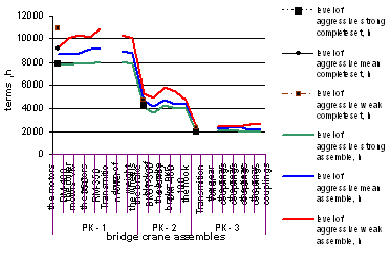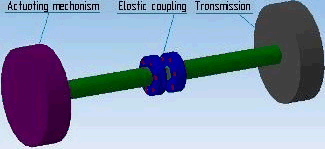


| DonNTU | Master's portal of DonNTU | RUS | UKR |
| |
|

Speciality: Lifting and Shifting, building, road, reclamation machines and equipment
Theme of Master's Work:
Justification of rational parameters of bridge crane special coupling working in the conditions of aggressive medium
Scientific adviser: Natalia Vodolazskaya
 |
Autobiography |  |
 |
 |
 |
 |
 |
 |
 |
Introduction
Bridge cranes are widely used as a means of mechanization of plant-floor operations in metallurgical industry. They are very effective carriers for the movement of loads of various categories. The reliability of these machines is determined by the perfection of their design and manufacturing technology and largely depends on the working conditions and the environment in which the crane is operated.
1. The state of the question
For the first time the question of studying of the effect of external gas environment on the magnitude of the frictional force and hence on wearing of machine parts was put by S. Jacob (1912), B. Hardy and J. Hardy (1919).
Later, the issue involved Ernst and M. Merchant, L.F. Coffin, Godfrey, I.G. Nosovskii, G.V. Vinogradov.
The influence of physically and chemically adsorbed films on the coefficient of friction was investigated by B.V. Derjaguin and V.P. Lazarev, A. Akhmatov, F. Bowden and G. Hyoz, V. Campbell, P. Shaw and E. Levy and others.
The questions of research of production environment were worked out by K.P. Berezhnova, Y.L. Volberg, S.M. Mihailov, M. Garipova, B.A. Nerush, A.M. Fantalova, V.I. Pavlov, N.A. Prischepa and others [1, 2].
2. The topicality of the issue
Technology of processing of non-ferrous metal ores is followed by the release of harmful gases, dust, moisture, vapor chemicals. Polluted by harmful substances gas-operational environment affects the metal structures and mechanical parts of cranes promoting their aging and destruction. Greatly aggressive environment increases the risk of equipment failure, aided by humidity, fumes and dust.
To insure the reliability of overhead cranes operated in aggressive environments of continuous metallurgical production is a priority, because cranes failures can cause disruptions in the processing chain of the enterprise, as it was noted earlier. From the standpoint of the reliability the weakest link in the bridge crane is a mechanical equipment (motors, brakes, cables, couplings etc.). Taking into account the results of the terms of exploitation of the equipment given below it should be noted that the most vulnerable assemblies are gear couplings as they have the least number of research terms of exploitation in the aggressive production environment [3].
Couplings are responsible element and determine the reliability of the engine unit. Coupling cost is small compared to the cost of an overhead crane, but the failure of the coupling increases the waste of time, which leads to considerable material losses.
In this connection the problem of making reliable and durable couplings, which are rather important joints of bridge cranes is an urgent task and has great significance in improving the quality and effectiveness of vehicle-handling transport service operations in the workplace.
3. Tasks and goals
The aim is to improve the structure of certain parts of bridge cranes to increase their durability and reliability at enterprises with an aggressive industrial environment.
To achieve this goal the following objectives and tasks were put:
1. There was made the analysis of the causes of destruction of metal structures and mechanical equipment failures of bridge cranes of metallurgical production, exploited in conditions of aggressive medium;
2. There was made the analysis of different types of couplings used in overhead cranes, working in conditions of aggressive medium;
3. The justification settings were made for the selected type of couplings;
Further plan is:
4. To eliminate the shortcomings connected with the plastic parts of the elastic coupling with coil springs;
5. To carry out the trademark search of material, the use of which would increase work stability of the coupling in terms of the production;
6. To find the optimal kind of lubricant.
4. Current results
Analysis of data obtained as a result of expert examination of average terms of exploitation of bridge crane assembles working in different environments of aggressiveness showed a realistic picture of resource dependency of overhead cranes units on the aggressiveness of the operational environment (fig. 1) [4].

Figure 1 – Average resources of basic repair complete sets of bridge crane,
working in various medium by the degree of aggressiveness
The graph shows that the gear couplings have the last terms of exploitation. This indicates that they are the most submitted to the influence of substances released upon isolation while producing non-ferrous metals. So there is quite appropriate need in replacement of the couplings for more reliable and resistant ones to aggressive environments [5].
The analysis of existing designs of couplings showed the necessity of selecting those the most suitable for the design and technical parameters, to the working conditions of the bridge crane. According to the basic parameters (the size, the coupling material, the value of the maximum transmitted torque and the ability to withstand heavy loads) the best choice was the elastic coupling with coil springs [6, 7, 8, 9].

Figure 2 – Sketch of plating of elastic coupling
(animation: size – 114 КB; image size – 325x149 px; shots quantity – 6;
number of repetition cycles – 7)
Coupling "Kardelis" presented in fig. 3. The clutch consists of two semi-couplings (1, 2), connected by a cylindrical coil springs (3). The springs are based on segment (4) which are fitted on pins (5).

Figure 3 – «Kardelis» coupling
Couplings are highly elastic, they soften load bumps and knocks load and they are characterized by a lack of free running. This is a very important indicator as the clutch is used in the mechanism of movement, and the quality of the work of the bridge crane depends greatly on the smoothness of that mechanism [9].
During the calculation, with the defined characteristics of the BC 5, we have found that the elastic coupling with coil springs are capable to transmit torque from output shaft gear to the road wheels of the bridge crane. The maximum torque transmitted by clutch within the scope of permissible (3046 N·m> 1353 N·m) [3].
Also, we have calculated the basic element couplings – helical springs (fig. 4).

Figure 4 – Screw compression spring
Based on the basic parameters of clutch (outer diameter, torque, number of fingers on one of the leading coupling halves) we have calculated the axial load acting on the springs (11330 N). Further calculation was carried out according to this force. Identified:
- wire diameter – 16 mm;
- step springs – 7 mm;
- number of turns – 5,5;
- the gap between the turns – 1,6 mm;
- outside diameter of spring – 60 mm.
We also have calculated the springs for durability. The condition of strength performed 621MPa < 1050MPa [13].
The summary results and key findings
Following the analysis of the causes of destruction of metal and mechanical parts of bridge cranes, we have identified assemblies of the bridge crane, which are most susceptible to an aggressive environment, they were gear couplings. In order to replace them, and thereby improve the design of the bridge crane we have analyzed types of couplings, the results are reported in this paper. However, the chosen type of coupling also has some disadvantages, which will be addressed through further work by improving the design and use of more wear-resistant materials for the manufacture of clutch and its components in particular.
REFERENCES
- Носовский, И.Г. Влияние газовой среды на износ металлов. / И.Г. Носовский. – Киев, 1968. - 172 с.
- Дроздов, Ю.Г. Трение и износ в экстремальных условиях. / Ю.Г. Дроздов, В.Г. Павлов, В.Н. Пучков – М.: Машиностроение, 1986. – 223с.
- Шевченко Д.А. Совершенствование отдельных узлов мостового крана, работающего в условиях металлургического производства. / Д.А. Шевченко, Н.В. Водолазская // материалы международной научно-техничной конференция «Прогресивні напрямки розвитку машино-приладобудівних галузей і транспорту» / Севаст. нац. техн. ун-т. – Севастополь, 2010. – С.180 -182.
- Старостина Ж.А. Совершенствование организации технической эксплуатации мостовых кранов в условиях агрессивной среды. // Автореферат диссертации [Електронний ресурс] /– Норильский индустр. ин-т. – Норильск: НИИ, 2007. – Режим доступа: www.lib.ua-ru.net/diss/cont/171574.html
- Айрапетов Э.Л. Зубчатые соединительные муфты. / Э.Л. Айрапетов, Д.Б. Мирзаджанов. – М.: Наука, 1991.–251с.
- Поляков В.С. Муфты. / В.С. Поляков, И.Д. Барбаш. – М.: Машгиз, 1960. – 367 с.
- Поляков В.С. Муфты. / В.С. Поляков, И.Д. Барбаш. – М. – Л.: Машгиз, 1964. – 364 с.
- Поляков В.С. Справочник по муфтам / В.С. Поляков, И.Д. Барбаш, О.А. Ряховский. – Ленинград.: Машиностроение, 1979. – 343 с.
- Ряховский О.А. Справочник по муфтам / О.А. Ряховский., С.С. Иванов. – Ленинград.: Политехника, 1991. – 384 с.
- Чайка Г.И. Руководство по курсовому проекту подъемно-транспортных машин / Г.И. Чайка – Харьков, 1963. – 280 c.
- Руденко Н.Ф. Курсовое проектирование подъемно-транспортных машин: ученик для вузов / Н.Ф. Руденко. – М. Машгиз, 1963. – 304 с.
- Васильев В.З. Детали машин: Справочник / В.З. Васильев, И.И. Георгиевский, А.Д. Дубяго, В.Г. Гаурок и др. –М. Машгиз, 1950. – 282 с.
- Кузьмин А.В. Расчеты деталей машин: справочное пособие/ А.В. Кузьмин, И.М. Чернин, Б.С. Козинцов. – 3-е изд., перераб. и доп. – Мн.: Выш. шк., 1986.-400с.
- Дунаев П.Ф. Детали машин. Курсовое проектирование: Учеб. пособие для машиностроит. спец. техникумов / П.Ф. Дунаев, О.П. Леликов. – М. Высш. Шк., 1984. – 336с.
Remark
The master’s work was not completed yet while writing this abstract of thesis. The date of completing is 1 December, 2010. The full text of the work and the material on this subject can be received from the author or its curator after the given date.
